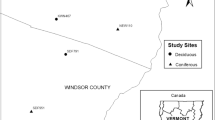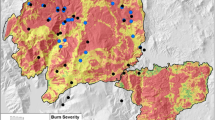Abstract
Seasonal forest pools (SFPs) are common, widespread, and provide critical habitat for amphibians and invertebrates. The ephemeral hydrology of SFPs has been identified as an important factor in the production of biologically active methylmercury (MeHg). To investigate mercury (Hg) in SFPs, we collected water, fine benthic organic matter (FBOM), detrital materials, and faunal samples from 10 pools in Massachusetts and Minnesota, across a range of basin morphometry, water chemistry, canopy closure, and hydroperiod. Total Hg (THg) and MeHg concentrations were comparable to other small, lentic waters. MeHg was found in greater concentrations in fauna than in periphyton, detrital items, or FBOM. In spite of consistently lower pool acidity and higher THg deposition in Massachusetts, we found no significant differences in Hg concentrations between states. No significant relationship was found between MeHg concentration and canopy closure. A weak, positive relationship was identified between pool hydroperiod and the bioaccumulation of THg, suggesting that longer exposure may be a factor in increased Hg concentrations in basal resources, which is then propagated into consumer trophic levels. Further work on the mechanisms determining Hg trophic transfer and bioaccumulation is required to fully understand the influence of hydrogeochemical and landscape influences on Hg dynamics in SFPs.


Similar content being viewed by others
References
Baker DB, Richards RP, Loftus TT, Kramer JW (2004) A new flashiness index: characteristics and applications to midwestern rivers and streams. Journal of the American Water Resources Association 40:503–522
Bank MS, Burgess JR, Evers DC, Loftin CS (2007a) Mercury contamination of biota from Acadia National Park, Maine: a review. Environmental Monitoring and Assessment 126:105–115
Bank MS, Crocker J, Connery B, Amirbahman A (2007b) Mercury bioaccumulation in green frog (Rana clamitans) and bullfrog (Rana catesbeiana) tadpoles from Acadia National Park, Maine, USA. Environmental Toxicology and Chemistry 26(1):118–125
Bell AH, Scudder BC (2005) Bioaccumulation of mercury in riverine periphyton, U.S. Geological Survey Open-File Report 2004–1446
Boening DW (2000) Ecological effects, transport, and fate of mercury: a general review. Chemosphere 40:1335–1351
Brooks RT (2004) Weather-related effects on woodland vernal pool hydrology and hydroperiod. Wetlands 24:104–114
Brooks RT (2009) Potential impacts of global climate change on the hydrology and ecology of ephemeral freshwater systems of the forests of the northeastern United States. Climatic Change 95:469–483
Brooks RT, Hayashi M (2002) Depth-area-volume and hydroperiod relationships of ephemeral (vernal) forest pools in southern New England. Wetlands 22:247–255
Brooks RT, Stone J, Lyons P (1998) An inventory of seasonal forest ponds on the Quabbin Reservoir watershed, Massachusetts. Northeastern Naturalist 5:219–230
Burne MR (2001) Massachusetts aerial photo survey of potential Verna pools. Natural Heritage and Endangered Species Program, Massachusetts Division of Fisheries and Wildlife, Westborough
Chen CY, Stemberger RS, Kamman NC, Mayes BM, Golt CL (2005) Patterns of Hg bioaccumulation and transfer in aquatic food webs across multi-lake studies in the northeast US. Ecotoxicology 14:135–147
Clausen B, Biggs BJF (2000) Flow variables for ecological studies in temperate streams: groupings based on covariance. Journal of Hydrology 237:184–197
Colburn EA (2004) Vernal pools: natural history and conservation. McDonald & Woodward Publishing Company, Blacksburg
Colburn EA, Weeks SC, Reed SK (2009) Diversity and ecology of vernal pool invertebrates. In: Calhoun AJK, de Maynadier PG (eds) Science and conservation of vernal pools in northeastern North America. CRC Press, Boca Raton, pp 105–126
Cook RP (1983) Effects of acid precipitation on embryonic mortality of Ambystoma salamanders in the Connecticut Valley of Massachusetts. Biological Conservation 27:77–88
DeGraaf RM, Rudis DD (1983) Amphibians and reptiles of New England: habitats and natural history. The University of Massachusetts Press, Amherst
Doyle KL (1997) Comparison of shrew species composition and food habits in forested temporary pond catchment basins and upland forest habitat. Thesis, Forestry and Wildlife Management, University of Massachusetts, Amherst
Driscoll CT, Holsapple J, Schofield CL, Munson R (1998) The chemistry and transport of mercury in a small wetland in the Adirondack region of New York, USA. Biogeochemistry 40:137–146
Driscoll CT, Han Y-J, Chen CY, Evers DC, Lambert KF, Holsen TM, Kamman NC, Munson RK (2007) Mercury contamination in forest and freshwater ecosystems in the northeastern United States. BioScience 5717–28
Evers DC, Han Y-J, Driscoll CT, Kamman NC, Goodale MW, Lambert KF, Holsen TM, Chen CY, Clair TA, Butler T (2007) Biological mercury hotspots in the northeastern United States and southeastern Canada. BioScience 57:29–43
Felix ZI, Wang Y, Schweitzer CJ (2010) Effects of experimental canopy manipulation on amphibian egg deposition. Journal of Wildlife Management 74:496–503
Galloway ME, Branfireun BA (2004) Mercury dynamics of a temperate forested wetland. Science of the Total Environment 325:239–254
Gbor PK, Wen D, Meng F, Yang F, Sloan JJ (2007) Modeling of mercury emission, transport, and deposition in North America. Atmospheric Environment 41:1135–1149
Gosner KL (1960) A simplified table for staging anuran embryos and larvae with notes on identification. Herpetologica 16:183–190
Grigal DF (2003) Mercury sequestration in forests and peatlands: a review. Journal of Environmental Quality 32:393–405
Gu B, Bian Y, Miller CL, Dong W, Jiang X, Liang L (2011) Mercury reduction and complexation by natural organic matter in anoxic environments. Proceedings of the National Academy of Sciences 108:1479–1483
Hall BD, St Louis VL, Rolfhus KR, Bodaly RA, Beaty KG, Paterson MJ (2005) The impact of reservoir creation on the biogeochemical cycling methyl and total mercury in boreal upland forests. Ecosystems 8:248–266
Halverson MA, Skelly DK, Kiesecker JM, Freidenburg LK (2003) Forest mediated light regime linked to amphibian distribution and performance. Oecologica 134:360–364
Herreid CF, Kinney S (1967) Temperature and development of the wood frog, Rana sylvatica, in Alaska. Ecology 48:579–590
Heyes A, Moore TR, Rudd JWM (1998) Mercury and methylmercury in decomposing vegetation of a pristine and impounded wetland. Journal of Environmental Quality 27:591–599
Hines NA, Brezonik PL (2007) Mercury inputs and outputs at a small lake in northern Minnesota. Biogeochemistry 84:265–284
Kamman NC, Chalmers A, Clair TA, Major A, Moore RB, Norton SA, Shanley JB (2005) Factors influencing mercury in freshwater surface sediments of northeastern North America. Ecotoxicology 14:101–111
Lathrop RG, Montesano P, Tesauro J, Zarate B (2005) Statewide mapping and assessment of vernal pools: a New Jersey case study. Journal of Environmental Management 76:230–238
Lewis ME, Brigham ME (2004) Low-level mercury, us geological survey techniques of water-resources investigations, Book 9, Chapter A5, Section 5.6.4, 26 p. http://water.usgs.gov/owq/FieldManual/chapter5/pdf/5.6.4.B_v1.0.pdf
Loftin CS (2010) Does mercury bioaccumulate in amphibians developing in vernal pools? Abstract, Geological Society of America, Northeastern and Southeastern Joint Meeting, Baltimore, MD. 13-16 March.
Miller EK, VanArsdate A, Keeler GJ, Chalmers A, Poissant L, Kamman NC, Brulotte R (2005) Estimation and mapping of wet and dry mercury deposition across northeastern North America. Ecotoxicology 14:53–70
Mitchell JC, Paton PWC, Raithel CJ (2009) The importance of vernal pools to reptiles, birds, and mammals. In: Calhoun AJK, deMaynadier PG (eds) Science and conservation of vernal pools in northeastern North America. CRC Press, Boca Raton, pp 169–190
Palik BJ, Batzer DP, Buech R, Nichols D, Cease K, Egeland L, Streblow DE (2001) Seasonal pond characteristics across a chronosequence of adjacent forest ages in northern Minnesota, USA. Wetlands 21:532–542
Palik B, Streblow D, Egeland L, Buech R (2007) Landscape variation of seasonal pool plant communities in forests of northern Minnesota. USA Wetlands 27:12–23
Pickhardt PC, Folt CL, Chen CY, Klaue B, Blum JD (2002) Algal blooms reduce the uptake of toxic methylmercury in freshwater food webs. Proceedings of the National Academy of Sciences USA 99:4419–4423
Poff NL, Ward JV (1989) Implications of streamflow variability and predictability for lotic community structure: a regional analysis of streamflow patterns. Canadian Journal of Fisheries and Aquatic Sciences 46:1805–1817
Pough FH (1976) Acid precipitation and embryonic mortality of spotted salamanders, Ambystoma maculatum. Science 192:68–70
Rheinhardt RD, Hollands GG (2009) Classification of vernal pools: geomorphic setting and distribution. In: Calhoun AJK, deMaynadier PG (eds) Science and conservation of vernal pools in northeastern North America. CRC Press, Boca Raton, pp 11–29
Rowe CL, Dunson WA (1995) Impacts of hydroperiod on growth and survival of larval amphibians in temporary ponds of central Pennsylvania, USA. Oecologia 102:397–403
Scheuhammer AM, Meyer MW, Sandheinrich MB, Murray MW (2007) Effects of environmental methylmercury on the health of wild birds, mammals, and fish. Ambio 36:12–18
Schiesari L (2006) Pond canopy cover: a resource gradient for anuran larvae. Freshwater Biology 51:412–423
Semlitsch RD, Skelly DK (2009) Ecology and conservation of pool-breeding amphibians. In: Calhoun AJK, deMaynadier PG (eds) Science and conservation of vernal pools in northeastern North America. CRC Press, Boca Raton pp, pp 127–147
Shanley JB, Samman NC, Clair TA, Chalmers A (2005) Physical controls on total and methylmercury concentrations in streams and lakes of northeastern USA. Ecotoxicology 14:125–134
Skelly DK, Freidenburg LK, Kiesecker JM (2002) Forest canopy and the performance of larval amphibians. Ecology 83:983–992
Snodgrass JW, Jagoe CH, Bryan AL, Brant HA, Burger J (2000) Effects of trophic status and wetland morphology, hydroperiod, and water chemistry on mercury concentrations in fish. Canadian Journal of Fisheries and Aquatic Sciences 57:171–180
Sorensen JA, Kellemeyn LW, Sydor M (2005) Relationship between mercury accumulation in young-of-the-year yellow perch and water-level fluctuations. Environmental Science and Technology 39:9237–9243
St. Louis VL, Rudd JWM, Kelly CA, Bodaly RA, Paterson MJ, Beaty KG, Hesslein RH, Hayes R, Majewski AR (2004) The rise of fall of mercury methylation in an experimental reservoir. Environmental Science and Technology 38:1348–1358
Unrine JM, Jagoe CH, Brinton AC, Brant HA, Garvin NT (2005) Dietary mercury exposure and bioaccumulation in amphibian larvae inhabiting Carolina bay wetlands. Environmental Pollution 135:245–253
Van Meter R, Bailey LL, Campbell Grant EH (2008) Methods for estimating the amount of vernal pool habitat in the northeastern United States. Wetlands 28:585–593
VanArsdale A, Weiss J, Keeler G, Miller E, Boulet G, Brulotte R, Poissant L (2005) Patterns of mercury deposition and concentration in northeastern North America. Ecotoxicology 14:37–52
Ward DM, Nislow KH, Folt CL (2010) Bioaccumulation syndrome: identifying factors that make some stream food webs prone to methylmercury accumulation. In: Ostfeld RS, Schlesinger (eds) The year in ecology and conservation biology 2010. Annals of the New York Academy of Sciences, New York, pp 62–83
Werner EE, Glennemeier KS (1999) Influence of forest canopy cover on the breeding pond distribution of several amphibian species. Copeia 1999:1–12
Wiener JG, Krabbenhoft DP, Heinz GH, Scheuhammer AM (2003) Ecotoxicology of mercury. In: Hoffman DJ, Rattner BA, Burton GA, Cairns J (eds) Handbook of ecotoxicology. Lewis Publishers, New York
Wiener JG, Bodaly RA, Brown SS, Lucotte M, Newman MC, Porcella DB, Reash RJ, Swain EB (2007) Monitoring and evaluating trends in methylmercury accumulation in aquatic biota. In: Harris R, Krabbenhoft DP, Mason R, Murray MW, Reasch R, Saltman T (eds) Ecosystem responses to mercury contamination—indicators of change. CRC Press, New York, pp 87–122
Williams DD (2006) The biology of temporary waters. Oxford University Press, Oxford
Wolfe MF, Schwarzbach S, Sulaiman RA (1998) Effects of mercury on wildlife: a comprehensive review. Environmental Toxicology and Chemistry 17:146–160
Wolfe MF, Atkeson T, Bowerman W, Burger J, Evers DC, Murray MW, Zillioux E (2007) Wildlife indicators. In: Harris R, Krabbenhoft DP, Mason R, Murray MW, Reasch R, Saltman T (eds) Ecosystem responses to mercury contamination—indicators of change. CRC Press, New York, pp 123–189
Acknowledgements
T. Humphrey provided critical support for the collection of Massachusetts samples and field data. E. Moreno processed the mercury samples and A. Baker and B. Jackson analyzed mercury speciation. The research was partially supported by the U.S. Forest Service Eastern Region Renewable Resources (S.L. Eggert) and the National Institutes of Health Grant P42 ESO7373 (C.Y. Chen) from the National Institute of Environmental Health Sciences. An earlier version of the manuscript was reviewed by two anonymous referees.
Author information
Authors and Affiliations
Corresponding author
Rights and permissions
About this article
Cite this article
Brooks, R.T., Eggert, S.L., Nislow, K.H. et al. Preliminary Assessment of Mercury Accumulation in Massachusetts and Minnesota Seasonal Forest Pools. Wetlands 32, 653–663 (2012). https://doi.org/10.1007/s13157-012-0298-4
Received:
Accepted:
Published:
Issue Date:
DOI: https://doi.org/10.1007/s13157-012-0298-4




